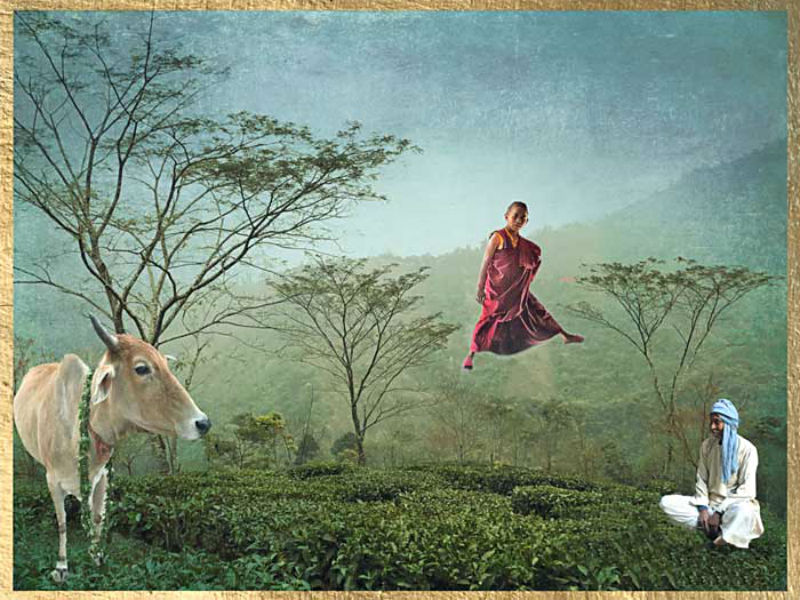Photographer Nina Hauser dreams of India in her new WSG Gallery show

The last time we saw Nina Hauser’s iPhone photography at the WSG Gallery was in May 2013. I was keenly struck at that time how her display illustrated the fundamental principle that the human element cannot be taken out of art irrespective of the technology used to make the work. The 22 photographs in that exhibit were marked by a remarkable technique and skill -- with both artful elements reflecting the “eye” implicit in the photographic image.
Hauser’s current exhibit at that same gallery, The Real World Is Not the Only World -- India Dreams, finds this local photographer immersed in her fascination with the culture of the Asian subcontinent -- and certainly sufficiently enough as to revolutionize her aesthetic.
Hauser once crafted her art through an extraordinarily meticulous photographic application and her control brooked no opposition. Indeed, Hauser has always been a photographer’s photographer and her restraint was near absolute, whether studied from the structure of her composition to the manipulation of her camera.
But that was yesterday -- and yesterday’s gone. What The Real World Is Not the Only World -- India Dreams instead champions is a new creativity that requires a new approach to her art.
“All that you see here are composites of images I’ve taken in India over the past three years,” says Hauser of this recent clutch of photographs. “What compelled me to pursue this body of work was an encounter with a Brahmin woman. She had watched me while I was photographing a woman sweeping away leaves from the grass with a little bundle of twigs, and was scornful of my interest in a Dalit or an 'untouchable' woman.
“Her reaction was the spark for this work. I began photographing women performing menial jobs such as working on road crews and sweeping up garbage. These women were the most striking and beautiful to me not because they were dressed in colorful, beautiful saris but because of their dignity and conscientiousness. They were such a startling contrast to the work they were doing.”
Yet this explanation doesn’t really fully cover the art. It merely touches upon the theme of these photographic essays. For what really captures Hauser’s work comes near the end of that statement -- and this information informs the whole of her effort.
“In my photographs,” Hauser says, “I began to move people and animals from where I found them into my own version of Indian Mughal paintings, using either copies of paintings or my own photographs. Mughal paintings are a particular style of South Asian painting, usually done in miniature, during the time of the Mughal Empire of the 16th to 18th centuries CE.
“My subjects,” she concludes, “are far from those in the vivid scenes of Hindu epics, mystical legends and courtly life usually depicted in this type of art. But my subjects are just as deserving of lush surroundings, and my people and animals just as noble and valuable.”
And we’re now reaching the core of Hauser’s most recent artistic development. While her prior photography had an elemental geometric purity that lent an integrity to the whole of the composition solely through its depiction, these latest works require a fanciful manipulated resolution for them to reach their fruition and Hauser’s reconstruction is meant to provide this meaning.

Mughal-style painting features stylized portraiture typically set in harmony with realistic birds, plants, and animals. Hauser’s supplement is, by contrast, two-fold within this prior tradition. First, and most crucially, she remains true to her photographic style. Second, the photos feature newfound fantastic qualities that have been arranged to heighten their iconographic meaning.
She’s therefore still working with her handy iPhone (more precisely, iPhone7+), but is now also reliant on an iPad to modify her compositional elements until indeed “the real world is not the only world.” It is, rather, a world of Hauser’s “Indian dreams.”
Take for example her 10x7 inch composite photograph on archival paper, Faith is the bird that feels the light when the dawn is still dark --R. Tagore. Quoting Bengali poet-philosopher Rabindranath Tagore (1861-1941), Hauser frames a supplicating Brahmin in the center of the artwork set against a gesturally abstracted background that shades from a mottled earth tone to dark blue horizon while a group of stylized swans fly above in the sky. Symbolizing avian beauty and grace, the swans richly reflect the spirituality that faith requires. Hauser thus illustrates the belief that what comes effortlessly to the natural kingdom is the largest part of discipline on our part as humans.
Even more whimsical is Hauser’s 7x10-inch composite Expressing the Inexpressible where a Buddhist novice is shown dramatically flying through the air through a lush landscape while a fellow in blue headdress sits stoically below to his right and a garlanded Brahman bull stands on his left. What she depicts may seem inexpressible, but the sheer exuberance of the youth is more than expressible enough.
Yet maybe the supreme expression of Hauser’s latest development is the delightful countenance of her 6.5x10-inch composite entitled Joyful Maybes. For in this work, a young girl in a bright green sari is set in the center of the composition flanked by women, animals, and a verdant backdrop that would comfortably fit a traditional Mughal painting. Hauser’s surrendered herself to her enthusiasm and it tells in this most captivating of her recent artworks where contemporary art meets Indian reverie.
John Carlos Cantú has written on our community's visual arts in a number of different periodicals.
"Nina Hauser: The Real World Is Not the Only World -- India Dreams" will run through November 25 at WSG Gallery, 306 S. Main St. Exhibit hours are Tuesday-Wednesday, 12-6 pm; Thursday, 12-9 pm; Friday and Saturday, 12-10 pm; and Sunday, 12-5 pm. For information, visit wsg-art.com or call 734-761-2287.


































